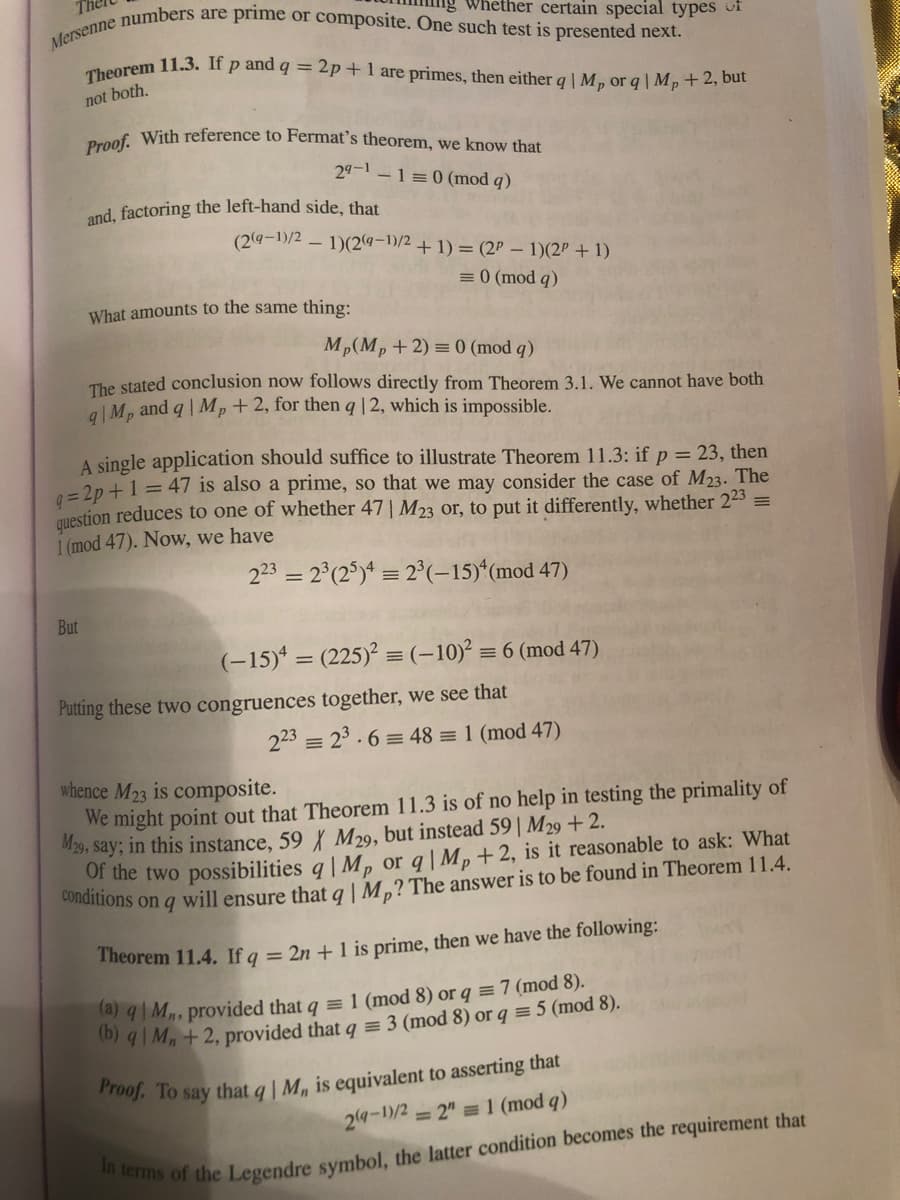Theorem 11.3. If p and q = 2p+1: primes, then either q | M, or q| M,+2, but are not both.
Theorem 11.3. If p and q = 2p+1: primes, then either q | M, or q| M,+2, but are not both.
Elements Of Modern Algebra
8th Edition
ISBN:9781285463230
Author:Gilbert, Linda, Jimmie
Publisher:Gilbert, Linda, Jimmie
Chapter2: The Integers
Section2.5: Congruence Of Integers
Problem 58E: a. Prove that 10n(1)n(mod11) for every positive integer n. b. Prove that a positive integer z is...
Related questions
Topic Video
Question
Proof short and simplified with clear letters

Transcribed Image Text:Mersenne numbers are prime or composite. One such test is presented next.
Proof. With reference to Fermat's theorem, we know that
Theorem 11.3. If p and q = 2p+1 are primes, then either q | M, or q | M,+2, but
Whether certain special types of
not both.
29-1 -1=0 (mod q)
and, factoring the left-hand side, that
(2(a-1)/2 – 1)(24-1)/2 + 1) = (2P – 1)(2P + 1)
= 0 (mod q)
What amounts to the same thing:
Mp(Mp+2) = 0 (mod q)
The stated conclusion now follows directly from Theorem 3.1. We cannot have both
a|Mp and q | Mp+2, for then q|2, which is impossible.
A single application should suffice to illustrate Theorem 11.3: if p = 23, then
=2p +1 = 47 is also a prime, so that we may consider the case of M23. The
question reduces to one of whether 47| M23 or, to put it differently, whether 223 =
1 (mod 47). Now, we have
223 = 2°(2°)* = 2°(-15)*(mod 47)
But
(-15)* = (225)? = (-10)² = 6 (mod 47)
Putting these two congruences together, we see that
223 = 23.6 = 48 = 1 (mod 47)
whence M23 is composite.
We might point out that Theorem 11.3 is of no help in testing the primality of
M29, say; in this instance, 59 M29, but instead 59| M29 +2.
Of the two possibilities q| M, or q| Mp+2, is it reasonable to ask: What
found in Theorem 11.4.
Theorem 11.4. If q = 2n + 1 is prime, then we have the following:
ta) q| M, provided that q = 1 (mod 8) or q = 7 (mod 8).
0) 9|M,+ 2, provided that q = 3 (mod 8) or q = 5 (mod 8).
24-1/2
= 2" = 1 (mod q)
Expert Solution
This question has been solved!
Explore an expertly crafted, step-by-step solution for a thorough understanding of key concepts.
This is a popular solution!
Trending now
This is a popular solution!
Step by step
Solved in 2 steps

Knowledge Booster
Learn more about
Need a deep-dive on the concept behind this application? Look no further. Learn more about this topic, advanced-math and related others by exploring similar questions and additional content below.Recommended textbooks for you

Elements Of Modern Algebra
Algebra
ISBN:
9781285463230
Author:
Gilbert, Linda, Jimmie
Publisher:
Cengage Learning,

College Algebra (MindTap Course List)
Algebra
ISBN:
9781305652231
Author:
R. David Gustafson, Jeff Hughes
Publisher:
Cengage Learning

Algebra & Trigonometry with Analytic Geometry
Algebra
ISBN:
9781133382119
Author:
Swokowski
Publisher:
Cengage

Elements Of Modern Algebra
Algebra
ISBN:
9781285463230
Author:
Gilbert, Linda, Jimmie
Publisher:
Cengage Learning,

College Algebra (MindTap Course List)
Algebra
ISBN:
9781305652231
Author:
R. David Gustafson, Jeff Hughes
Publisher:
Cengage Learning

Algebra & Trigonometry with Analytic Geometry
Algebra
ISBN:
9781133382119
Author:
Swokowski
Publisher:
Cengage